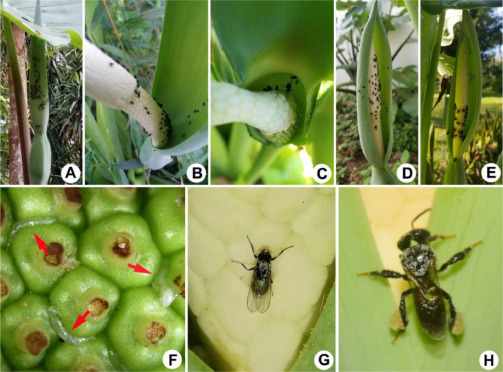Thermogenesis is literally defined as heat production. Floral thermogenesis is a process that reproductive structures of some plants produce heat, which is critical for flower organ development and reproductive success. However, floret (or inflorescence) development, thermogenesis and pollinator activity is rarely studied in association.
In a recent study published in the journal Flora, researchers from Xishuangbanna Tropical Botanical Garden (XTBG) observed the relationship between blooming, floral temperature and insect activity in Alocasia odora, an understory clonal herb known to produce unisexual flowers and hermaphroditic inflorescences.
The researchers used thermologgers as well as an infra-red camera to demonstrate the spatial pattern of thermogenesis in A. odora inflorescences during different stages. They also examined floral development, patterns of heat production, and insect activity on the inflorescence, and determined the association among these factors.
Based on morphological changes of the spathe, the researchers divided inflorescence into four stages: spathe closing (stage I), spathe unfolding, female florets receptive (stage II), male florets releasing pollen (stage III), and spathe withering(stage IV ).
They showed that different inflorescences of A. odora had similar but not completely identical thermogenetic duration and heat production intensity. The thermogenic patterns between the male flowers and the appendix differed in terms of the duration and temporal dynamics.
They observed that fruit flies (Colocasiomyia) mate, feed on the inflorescence, and enter the female zone to lay eggs when the spathe just opened at stage II. The heat production and the spathe provided favorable living and breeding conditions for Colocasiomyia flies, and Colocasiomyia flies effectively pollinated A. odora. Therefore, the interactions between A. odora and Colocasiomyia flies are mutually beneficial.
“Our results therefore suggest that floral thermogenesis plays an important role in successful reproduction,” said Prof. PENG Yanqiong, principal investigator of the study.
Contact
PENG Yanqiong Ph.D Principal Investigator
Key Laboratory of Tropical Forest Ecology, Xishuangbanna Tropical Botanical Garden, Chinese Academy of Sciences, Mengla, Yunnan 666303, China
E-mail: pengyq@xtbg.ac.cn

Visitors of the spadices of Alocasia odora. (Image by BIAN Fuhua)

